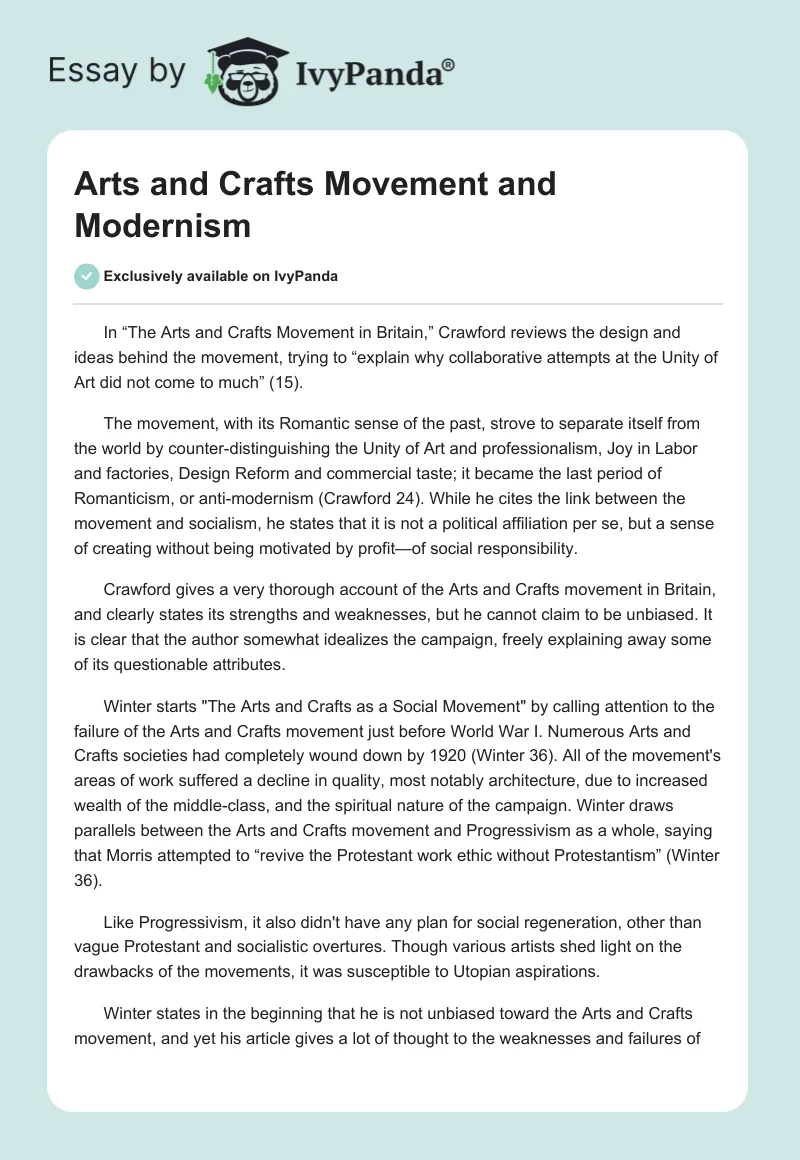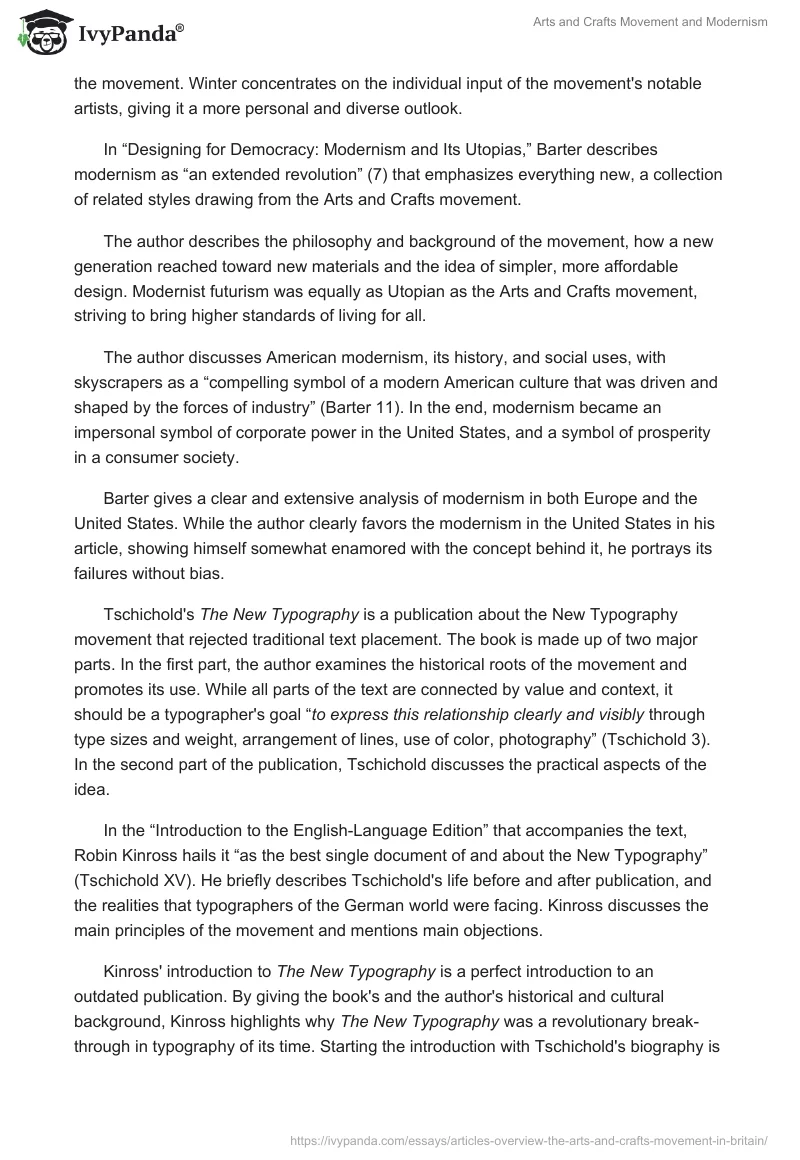In “The Arts and Crafts Movement in Britain,” Crawford reviews the design and ideas behind the movement, trying to “explain why collaborative attempts at the Unity of Art did not come to much” (15).
The movement, with its Romantic sense of the past, strove to separate itself from the world by counter-distinguishing the Unity of Art and professionalism, Joy in Labor and factories, Design Reform and commercial taste; it became the last period of Romanticism, or anti-modernism (Crawford 24). While he cites the link between the movement and socialism, he states that it is not a political affiliation per se, but a sense of creating without being motivated by profit—of social responsibility.
Crawford gives a very thorough account of the Arts and Crafts movement in Britain, and clearly states its strengths and weaknesses, but he cannot claim to be unbiased. It is clear that the author somewhat idealizes the campaign, freely explaining away some of its questionable attributes.
Winter starts “The Arts and Crafts as a Social Movement” by calling attention to the failure of the Arts and Crafts movement just before World War I. Numerous Arts and Crafts societies had completely wound down by 1920 (Winter 36). All of the movement’s areas of work suffered a decline in quality, most notably architecture, due to increased wealth of the middle-class, and the spiritual nature of the campaign. Winter draws parallels between the Arts and Crafts movement and Progressivism as a whole, saying that Morris attempted to “revive the Protestant work ethic without Protestantism” (Winter 36).
Like Progressivism, it also didn’t have any plan for social regeneration, other than vague Protestant and socialistic overtures. Though various artists shed light on the drawbacks of the movements, it was susceptible to Utopian aspirations.
Winter states in the beginning that he is not unbiased toward the Arts and Crafts movement, and yet his article gives a lot of thought to the weaknesses and failures of the movement. Winter concentrates on the individual input of the movement’s notable artists, giving it a more personal and diverse outlook.
In “Designing for Democracy: Modernism and Its Utopias,” Barter describes modernism as “an extended revolution” (7) that emphasizes everything new, a collection of related styles drawing from the Arts and Crafts movement.
The author describes the philosophy and background of the movement, how a new generation reached toward new materials and the idea of simpler, more affordable design. Modernist futurism was equally as Utopian as the Arts and Crafts movement, striving to bring higher standards of living for all.
The author discusses American modernism, its history, and social uses, with skyscrapers as a “compelling symbol of a modern American culture that was driven and shaped by the forces of industry” (Barter 11). In the end, modernism became an impersonal symbol of corporate power in the United States, and a symbol of prosperity in a consumer society.
Barter gives a clear and extensive analysis of modernism in both Europe and the United States. While the author clearly favors the modernism in the United States in his article, showing himself somewhat enamored with the concept behind it, he portrays its failures without bias.
Tschichold’s The New Typography is a publication about the New Typography movement that rejected traditional text placement. The book is made up of two major parts. In the first part, the author examines the historical roots of the movement and promotes its use. While all parts of the text are connected by value and context, it should be a typographer’s goal “to express this relationship clearly and visibly through type sizes and weight, arrangement of lines, use of color, photography” (Tschichold 3). In the second part of the publication, Tschichold discusses the practical aspects of the idea.
In the “Introduction to the English-Language Edition” that accompanies the text, Robin Kinross hails it “as the best single document of and about the New Typography” (Tschichold XV). He briefly describes Tschichold’s life before and after publication, and the realities that typographers of the German world were facing. Kinross discusses the main principles of the movement and mentions main objections.
Kinross’ introduction to The New Typography is a perfect introduction to an outdated publication. By giving the book’s and the author’s historical and cultural background, Kinross highlights why The New Typography was a revolutionary break-through in typography of its time. Starting the introduction with Tschichold’s biography is a well-calculated move, aimed at making the reader take a more personal look at the material.
The only aspect that doesn’t seem to be fully revealed is the opposition to the New Typography movement, which makes the introduction look rather one-sided.
The book Cultural Criticism: A Primer of Key Concepts by Berger is a valuable introductory text that presents a wide variety of theories and concepts, such as literary theory, Marxism, semiotics, and psychoanalytical and sociological theories, in the context of cultural criticism.
In the fourth chapter, Berger discusses the basic concepts of semiotics, “the science of signs” (73), sign functioning according to Peirce’s and Saussure’s systems, and the differences between index, sign, and symbol definitions in those systems. Berger gives definitions of connotation, denotation, metaphor, metonymy, and their subcategories, along with the opinions of various authors on their purpose in the language.
Cultural Criticism: A Primer of Key Concepts by Berger is the most academic, in comparison to the works above. It approaches semiotics as a concept that can be, and is, widely used in all types of art in everyday life. Consequently, Berger gives the reader a fascinating outlook on the choice of symbols in both the Arts and Crafts movement and modernism.
References
Barter, Judith A. “Designing for Democracy: Modernism and Its Utopias.” Art Institute of Chicago Museum Studies 27.2 (2001): 7-105. Web.
Berger, Arthur Asa. Cultural criticism: a primer of key concepts. Thousand Oaks: Sage Publications, 1995. Print.
Crawford, Alan. “Ideas and Objects: The Arts and Crafts Movement in Britain.” Design Issues 13.1 (1997): 15-26. Print.
Tschichold, Jan. The New Typography: A Handbook for Modern Designers. Berkeley: University of California Press, 1995. Print.
Winter, Robert W. “The Arts and Crafts as a Social Movement.” Record of the Art Museum, Princeton University 34.2 (1975): 36-40. Web.


